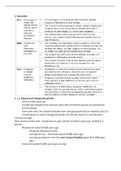2. Glaciation
2. 1. a. Glacial and interglacial periods
- Earth is 4.6bn years old
- Climate has changed from icehouse Earth (with continental glaciers) to greenhouse
Earth (without)
- During this time, the climate fluctuates from cold glacial periods (ice expands, low CO2
concentration) to warm interglacial periods (ice retreats, high CO2 concentration)
5 known ice ages:
Most recent (current one) - Quaternary ice age: started 2.6 million years ago. Divided in 2
epochs:
- Pleistocene: ended 10 000 years ago
- 50 glacial-interglacial cycles
- Last glacial max. - Devensian (about 18 000 years ago)
- Last glacial advance in the UK: Loch Lomond Stadial (about 10-12 000 years
ago)
- Holocene: started 10 000 years ago to today
,2. 1. b. Long/short term causes of climate change
Long term:
- Continental drift
The start of the Quaternary ice age is linked to the collision of N and S America 3 million years
ago. The warm Caribbean waters were forced towards Europe (Gulf stream) -> extra moisture
into the Arctic -> more snowfall -> ice build-up, set off feedback mechanism: increased albedo
effect, lower temperatures, more ice spreading.
- Milankovitch cycles (primary driver of climate change)
1920, Milankovitch proposed that glacial-interglacial periods were caused by
variations in the amount of solar radiation received by the Earth. Changes are caused
by:
● Eccentricity cycles: the shape of the Earth’s orbit changes from circular to
elliptical every 100 000 years. Elliptical -> further away from the Sun -> less
energy
● Obliquity cycles: the tilt of the Earth varies between 21.5º and 24.5º over 41
000 years. Changes the amount of energy received at the poles and the
severity of the seasons.
● Precession of the equinoxes: the Earth wobbles as it spins -> the season in
which the Earth is closest to the sun (perihelion (furthest is aphelion)) varies
every 21 000 years. Currently, N hemisphere winters are in perihelion - closer
to the Sun, making them milder.
Short term:
- Volcanic emissions
In 1815, Mt Tambora (Indonesia) had one of the most powerful eruptions ever recorded.
There was very cold weather across the whole Earth the following year. Initially, it was
thought it was the ash that blocked sun rays but it was discovered that its actually the
SO2 emitted which reflected radiation back into space.
- Variations in solar output
Scientists count the number of dark patches (sunspots) on the Sun. The amount varies every 11
years. When there are more sunspots = Sun’s more active -> more energy.
- Maunder minimum: little sunspot activity recorded from 1640-1725
- Little Ice age: from 1300 - 1870 - cooler temperatures. Could have been
triggered by volcanic emissions and variations in solar output.
2. 1. c. Loch Lomond Stadial (P) and Little Ice Age (H)
The Loch Lomond Stadial was a period of glacial readvance during the overall shrinking of the
British-Irish Ice Sheet. By the end of the Loch Lomond Stadial, all the ice fields and glaciers in
Britain had entirely receded, and all the ice had gone.
, The Little Ice Age was a climate interval that occurred from 1300 - 1870,
when mountain glaciers expanded at several locations, including the
European Alps, New Zealand, Alaska, and the southern Andes, and
mean annual temperatures across the Northern Hemisphere declined
by 0.6 °C.
2. 2. a. Cryosphere and ice mass classification
- Cryosphere: refers to the cold environments of our planet where water is solid,
- Included: sea ice, lake ice, river ice, snow cover, glaciers, ice caps, ice sheets and
permafrost (permanently frozen ground).
- Has an important regulatory role in the global climate, by reducing global
temperatures by reflecting the Sun’s heat off its white surface (albedo effect)
and storing 69% of all freshwater. Antarctica makes up 85% of the cryosphere
today.
- Also, the most sensitive regions to temperature change, makes them important
research and observation areas for climate change
- Polar glacial environments: high latitudes of the Antarctic and Arctic. Extremely cold
temperatures and low levels of precipitation.
- Alpine glacial environments: high altitudes in mountain ranges and mid to low
latitudes. European Alps, Himalayas, Andes. High levels of precipitation, wide
temperature range, frequent freeze-thaw cycles.
- Glaciers: slow moving bodies of ice in valleys. Shape the landscape in both polar and
alpine environments.
- Periglacial environments: do not feature glaciers, usually found next to glacial
environments. Characterised by permafrost. High latitude or high altitude areas.
Siberia, Alaska, Northern Canada.
- Global distribution of glacial ice changed during the glacial-interglacial cycles of the
Pleistocene.
Other key terms:
Carbon dating: using radioactive testing to find the age of rocks when contained living
material
Erosion: the wearing away of the landscape




